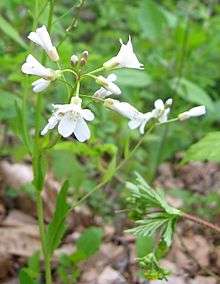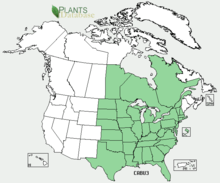Cardamine bulbosa
Cardamine bulbosa, commonly called bulbous bittercress[2] or spring cress[3], is a perennial plant in the mustard family. It is native to a widespread area of eastern North America, in both Canada and the United States.[4] Its natural habitat is moist soils of bottomland forests and swamps, often in calcareous areas.[2]
| Cardamine bulbosa | |
|---|---|
 | |
| Scientific classification | |
| Kingdom: | Plantae |
| Clade: | Tracheophytes |
| Clade: | Angiosperms |
| Clade: | Eudicots |
| Clade: | Rosids |
| Order: | Brassicales |
| Family: | Brassicaceae |
| Genus: | Cardamine |
| Species: | C. bulbosa |
| Binomial name | |
| Cardamine bulbosa | |
 | |
| Natural range in North America | |
| Synonyms | |
| |
In late spring and early summer, white flowers are produced well above the foliage.[5] Its leaves are edible, and have a peppery taste.[6]
References
- Cardamine bulbosa (Schreb. ex Muhl.) Britton, Sterns & Poggenb. The Plant List
- "Flora of the Southern and Mid-Atlantic States".
- "Cardamine bulbosa (Spring Cress)". Minnesota Wildflowers. Retrieved 18 May 2020.
- "Cardamine bulbosa". County-level distribution map from the North American Plant Atlas (NAPA). Biota of North America Program (BONAP). 2014. Retrieved 26 January 2017.
- Flora of North America
- GoBotany - New England Wildflower Society
This article is issued from Wikipedia. The text is licensed under Creative Commons - Attribution - Sharealike. Additional terms may apply for the media files.
